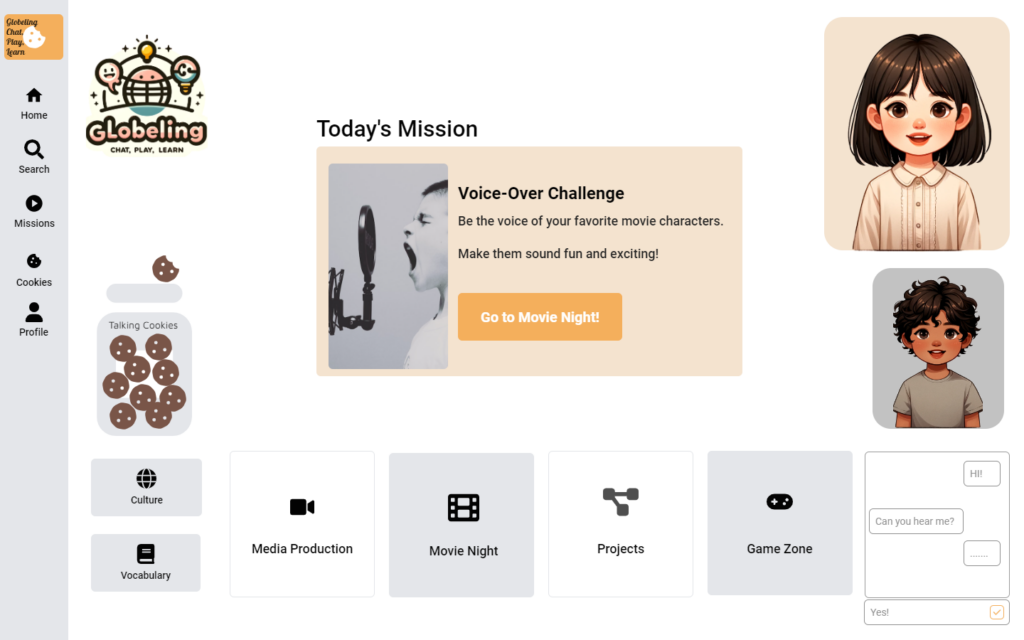Featured Image created by DALL·E 3
Welcome to a world where language practice is engaging and meaningful for children!
GlobeLing is an online platform for elementary students to practice a foreign language by participating in interactive projects, enjoying movie nights, creating media, and playing games. It connects classrooms from around the world, allowing students to communicate and collaborate in the language they are learning. The focus is on speaking fluently and confidently, rather than just grammatical accuracy, to prepare students for real-life conversations. All activities are designed to require active participation from every student, ensuring a balanced and practical language practice experience.
Rethinking Language Practice
- Traditional methods often focus solely on accuracy, not on fluency and free speaking.
- They lack real-world context, leading to lower motivation and engagement among young learners.
- Our platform is designed to make language practice authentic, interactive, and fun, inspiring kids to find their own meaning in language learning.
Global Connections Through Language
Description of Partnerships:
- Schools from diverse countries partner up, creating a global learning community.
- Children are paired with peers learning the same language, fostering genuine communication skills.
Purpose and Language Practice:
- This platform goes beyond traditional learning; it’s about connecting children worldwide, teaching them the importance of language as a tool to bridge cultures.
- Participants communicate only in the language they are learning, ensuring authentic practice and immersion, not relying on their first language.
GlobeLing Homepage

The GlobeLing platform is an interactive, child-friendly language practice environment designed for elementary school children.
- Duration & Partnering: Each session lasts between 40 to 60 minutes, where children are paired with the same partner throughout their learning journey.
- Icebreaking: Sessions begin with an icebreaker question to foster a comfortable and engaging starting point for the children.
- Mission Centerpiece: Every lesson features a new “mission” presented in the center of the dashboard, guiding the focus of the session.
- Activity Areas: Depending on the mission, children navigate to one of four activity areas: Media Production, Movie Night, Projects, or Game Zone.
- Instructional Videos: Upon entering an activity area, children watch a video that explains the activity, providing guidance in the absence of a live teacher.
- Recording of Activities: All activities are recorded for the teacher to review later, ensuring progress tracking and quality control.
- Talking Cookies: The Cookies represent the participation tracking system. Each child ‘eats’ a cookie from the jar upon participating. The goal is for both children to finish their cookies at a similar pace to promote equal participation. Once a child has used all their cookies, they must wait for their partner to finish, encouraging cooperation. Then, they can visit the “Cookies” page to ‘refill’ their jar.
- Culture & Vocabluary: The culture tab provides insights into the customs and traditions associated with the language, while the vocabulary tab provides new words and phrases used in their activities. These resources enrich the learning experience by providing context and meaning to the language practice.
This platform emphasizes cooperative learning and equal participation, focusing on practical language use and cultural exchange in a non-competitive, supportive environment.
Authentic Language Practice Activities
When designing learning activities, it’s important to ensure that they are age-appropriate, culturally sensitive, and cater to different learning styles. Also, integrating technology can enhance the interactivity and global connectivity of these experiences. The ultimate goal is to make language practice not just educational but also enjoyable and meaningful, encouraging students to apply their language skills in diverse and practical contexts.
Sample Lesson Plans
(Sample 1) Movie Night: Voice-Over Activities
Objective:
- Improve listening and speaking skills in the target language.
- Enhance pronunciation and intonation.
- Encourage collaboration and communication between students.
- Provide a real-world context for language learning by using movie clips.
Grade: 3rd to 5th grade Duration: 40 minutes
Procedure:
- Ice-Breaking Question (5 minutes): Students start the activity with an ice-breaking question to get to know each other better.
- Introduction and Demonstration (5 minutes): Students watch a demonstration video explaining the objective and procedure of the activity.
- Listening and Filling in the Blanks (15 minutes): In their pairs, students listen to the movie clip while collaboratively filling in the blanks in the subtitles. They can discuss with their partner and come to a consensus on the answers. They will have a maximum of 5 times to listen to the clip.
4. . Voice-Over Challenge (10 minutes):Once all the blanks are filled in, pairs will perform a voice-over for the movie clip, practicing their pronunciation, intonation, and expression in the target language.
5. Comparison and Reflection (5 minutes): After the voice-over, students will be shown the movie clip with the correct subtitles. They can compare their answers and discuss any differences.
(Sample 2) Project: Making a Cookbook
Objective:
Students will collaborate to create a digital cookbook featuring traditional recipes from countries where the target language is spoken, enhancing their language skills and cultural understanding.Lesson Duration: 1 hour
Ice-Breaker (3 minutes)
Each student shares their favorite food and a brief story or reason why it’s their favorite, using the target language.
Task Explanation (2 minutes)
Students watch a pre-recorded video explaining the task: to research and compile a digital cookbook with traditional recipes from the language’s native countries.
Research Phase (15 minutes)
Students use online resources to find traditional recipes from countries where the target language is spoken. Then they discuss and select recipes that are culturally significant and appropriate for their cookbook.
Recipe Compilation (20 minutes)
Students collaboratively input the chosen recipes into the shared document.
They ensure each entry includes the recipe name, ingredients, instructions, and cultural notes, all in the target language.
Presentation Preparation (10 minutes)
Each student selects one recipe to focus on for their presentation.
They prepare a brief script explaining the recipe, its significance, and any personal connection they may have to it.
Practice and Record Presentations (10 minutes)
Students practice their presentations briefly with their partner.
They record their presentations, ensuring they speak clearly and accurately in the target language.
(Sample 3) Media Production: School Day Broadcast Interviews
“School Day Broadcast Interviews”
Objective: Students will interview each other about their school day, simulating a live broadcast. Using phrases provided on screen, they will collaboratively formulate questions, practice active listening, and share personal experiences, all while speaking English.
Grade: 3rd-5thDuration: 40 minutes
- Ice-breaking Session (5 minutes):
- Both students take turns answering the question: “What’s your favorite thing to do after school or on weekends?” This allows them to share about their personal interests and activities outside of the school environment.
- Watch Sample Video (5 minutes):
- Students then watch a sample video of a mock “School Day Broadcast Interview” to give them an understanding of the activity’s format and what’s expected.
3. Collaborative Question Formulation (15 minutes):
a. Phrases or sentence starters are displayed on the screen. Examples include:
- “Tell me about…”
- “How did you feel when…”
- “What was it like to…”
- “Describe the moment…”
- “Who did you…”
b. Using these prompts, both students collaboratively come up with 3-4 questions each about their school day. They discuss and refine the questions together.
4. Live Interviews (15 minutes):
a. One student starts as the interviewer, using the questions they both formulated, while the other is the interviewee sharing about their school day.
b. They then switch roles.
c. They should try to ask any spontaneous follow-up questions based on the answers they receive to encourage a fluid conversation.
(Sample 4) Game Zone: Escape room
Introduction and Storyline: Students view a short story or video explaining why they are in the “locked” room and what they need to do to escape.
Room Structure: The game will consist of 5 rooms, each with a different theme related to English language learning (e.g., vocabulary, grammar, pronunciation, etc.). Students must complete the challenges in each room to unlock the door and move on to the next room.
Challenge Types:
- Multiple Choice Questions: Test the students’ knowledge of vocabulary, grammar rules, and sentence structure.
- Open-Ended Questions: Ask the students to write short sentences or paragraphs to demonstrate their understanding of English in context.
- Puzzle Challenges: Include puzzles that require students to use their English skills to solve, such as word searches, crosswords, or jigsaw puzzles with English words or phrases.
Featured Image created by DALL·E 3



